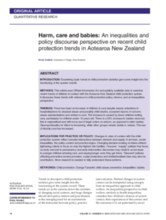ABSTRACT
INTRODUCTION: Examining basic trends in child protection statistics give some insight into the functioning of the system overall.
METHODS: This article uses Official Information Act and publicly available data to examine recent trends of children in contact with the Aotearoa New Zealand child protection system. It discusses these trends with reference to child protection policy reforms, and an inequalities perspective.
FINDINGS: There has been an increase of children in care despite steady reductions in hospitalisations for physical abuse and possibly child deaths, accepted reports of concern, abuse substantiations and entries to care. The increase is caused by fewer children exiting care, particularly for children under 10 years old. There is a 33% increase in babies removed; this is regionalised and with more use of legal orders on unborn, as opposed to older babies. Disproportionality for Maori is increasing, while other groups remain stable or reduce. The use of kinship care has increased.
IMPLICATIONS FOR PRACTICE OR POLICY: Changes in rates of contact with the child protection system reflect complex interactions between demand and supply of services, social inequalities, the policy context and practice logics. Changing decision-making at intake reflects tightening criteria to focus on only the highest risk families. However, “supply” policies that focus on early removal to permanency and early-intervention discourses may result in an increase in younger children entering care, and staying longer once they get there. “Demand” policies affecting preventive service provision, social protections and institutionalised bias may also be contributors. More research is needed to fully understand these patterns.

